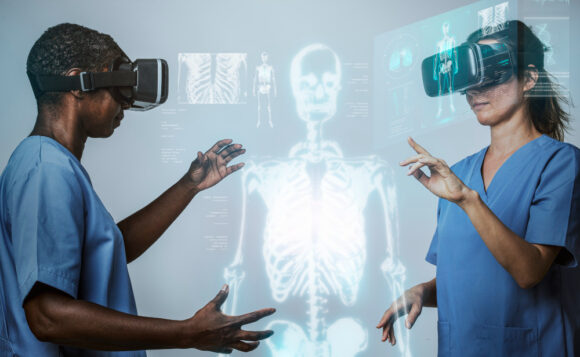
In healthcare, technological advances are constantly changing approaches to patient care and physician training. And augmented and mixed reality are among such innovations that have captured the attention of both healthcare professionals and researchers. Thanks to AR and MR, there are new ways to sharpen the work of surgeons and present educational materials for students and interns who are learning to work with patients.
In this article, we will explore in detail the intricacies of mixed and augmented reality in healthcare and explore their applications and benefits.
Primary Benefits
Modern hospitals are increasingly paying attention to augmented reality because it provides doctors and patients with such benefits as
- Improving processes visualization in education. As it has been repeatedly proven, immersive technologies can significantly improve the success rate of students who will become doctors. The first case is a digital visual accompaniment to books on the study of anatomy, which allows you to understand the structure of the human body better. The second one is interaction with a digital human body, which is an alternative to autopsies of real ones in cases when medical students do not have the opportunity to visit a real morgue. In addition, through a smartphone screen or MR glasses, students can independently interact with the digital organs of the body and learn more about their components.
Read also: Augmented Reality Books: Next Chapter in Interactive Reading
- Reducing the percentage of medical errors. The introduction of immersive technologies in hospitals and medical facilities reduces the percentage of medical errors, some of which can even lead to fatal consequences: from an incorrect diagnosis to an error during surgery. So, 40,000 to 80,000 patients die every year due to doctors’ mistakes. To reduce patient mortality and optimize the process of diagnosis and treatment, doctors are introducing augmented reality for training interns and AR-projection for training and direct operations.
- Increasing patient engagement. Visual digital content that can be interacted with allows not only professionals but also patients to better familiarize themselves with the processes in their own bodies. And augmented reality can be useful for studying the algorithm of health care and rehabilitation, where immersive technologies transform classic monotonous exercises into an exciting, gamified process.
Read also: Virtual Reality is the innovative way of patient’s recovery
Spotlighting the Effective Use Cases of AR and MR
AR at the Operating Table: Inspiring Applications Shaping Surgery’s Future
With the help of augmented and mixed reality, collaborations between doctors during surgeries become easier and more accessible. Especially when experienced doctors need to advise young interns during complex surgical procedures. Like, for example, the Proximie medical AR platform for professional specialists, which allows them to virtually move into the operating room and consult other specialists from the beginning to the end of a complex procedure.
A device, connected to the Internet, allows a doctor not only to see the entire process of the operation but also to superimpose body scans and X-rays on the patient’s body and point out to another specialist the areas that he should pay attention to.
How AR and MR Revolutionize Symptoms Recognition in Healthcare
Augmented reality training will help doctors determine the symptoms of a patient’s disease in a certain organ of the body. An example of such an application is the EyeDecide app created by OrcaMD, which allows you to simulate the activity of the human eye during a particular disease.
This application was created so that doctors could more clearly show patients the consequences of a particular disease. For example the patient can learn about how the eye with cataract disease sees.
AR and MR’s Impact on Medical Training Success
Virtual and augmented reality training has long proven its effectiveness due to the fact that the employee acquires new knowledge and consolidates new skills in the most realistic environment. AR training for physicians is no exception.
Like, for example, the CAE AresAR app that was built for medical students who use Microsoft Hololens 2. In this application, students learn the structure of the human body using the example of a digital copy of it lying on a real hospital bed. Also, doctors and students can interact with digital organs and study not only their structures but also how they work. For example, the video shows students zooming in on a digital model of a beating heart.
Read also: How To Improve Your Manufacturing With VR Training
How AR and MR are Reshaping Patient Evaluation
Besides of the professional help of doctors, patients can independently monitor the state of their own health. Augmented reality can give even greater independence in self-treatment and rehabilitation, with the visual digital content superimposed on the real world, they get more information about the state of their body and get more familiar with instructions on how to behave during a deterioration of health.
This option for patients is provided by the Know My Beat AR application, developed by British specialists. With this application, patients can independently monitor their own pulse and also learn to identify the symptoms of fibrillation themselves.
Augmented and mixed reality provides innovative and comfortable treatment of patients in various directions — from surgeons who receive AR instructions in real time to medical students who work with complex anatomical models. Thanks to digital technologies, doctors can quickly and clearly learn the skills of treating patients and reduce the percentage of medical errors. Meanwhile, patients can actively participate in their treatment plans through interactive visualization. As we look to the future, the convergence of AR with healthcare promises even more breakthroughs — from improved diagnostic accuracy to personalized therapeutic interventions.
Image: Freepik



